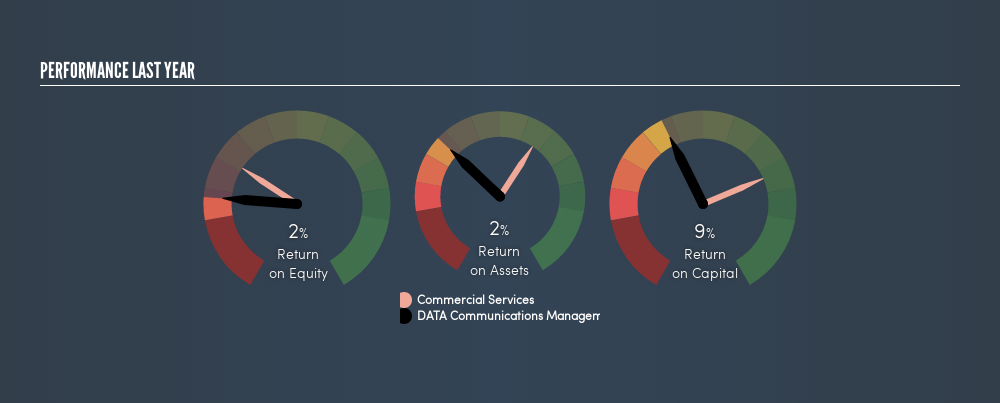- Canada
- /
- Commercial Services
- /
- TSX:DCM
Is DATA Communications Management Corp. (TSE:DCM) Better Than Average At Deploying Capital?

Want to participate in a short research study? Help shape the future of investing tools and you could win a $250 gift card!
Today we'll evaluate DATA Communications Management Corp. (TSE:DCM) to determine whether it could have potential as an investment idea. Specifically, we're going to calculate its Return On Capital Employed (ROCE), in the hopes of getting some insight into the business.
First of all, we'll work out how to calculate ROCE. Next, we'll compare it to others in its industry. Then we'll determine how its current liabilities are affecting its ROCE.
Return On Capital Employed (ROCE): What is it?
ROCE is a measure of a company's yearly pre-tax profit (its return), relative to the capital employed in the business. All else being equal, a better business will have a higher ROCE. Overall, it is a valuable metric that has its flaws. Renowned investment researcher Michael Mauboussin has suggested that a high ROCE can indicate that 'one dollar invested in the company generates value of more than one dollar'.
How Do You Calculate Return On Capital Employed?
Analysts use this formula to calculate return on capital employed:
Return on Capital Employed = Earnings Before Interest and Tax (EBIT) ÷ (Total Assets - Current Liabilities)
Or for DATA Communications Management:
0.088 = CA$12m ÷ (CA$203m - CA$73m) (Based on the trailing twelve months to March 2019.)
So, DATA Communications Management has an ROCE of 8.8%.
Check out our latest analysis for DATA Communications Management
Does DATA Communications Management Have A Good ROCE?
When making comparisons between similar businesses, investors may find ROCE useful. We can see DATA Communications Management's ROCE is around the 8.8% average reported by the Commercial Services industry. Aside from the industry comparison, DATA Communications Management's ROCE is mediocre in absolute terms, considering the risk of investing in stocks versus the safety of a bank account. It is possible that there are more rewarding investments out there.
DATA Communications Management's current ROCE of 8.8% is lower than 3 years ago, when the company reported a 20% ROCE. So investors might consider if it has had issues recently.

When considering ROCE, bear in mind that it reflects the past and does not necessarily predict the future. ROCE can be misleading for companies in cyclical industries, with returns looking impressive during the boom times, but very weak during the busts. This is because ROCE only looks at one year, instead of considering returns across a whole cycle. How cyclical is DATA Communications Management? You can see for yourself by looking at this free graph of past earnings, revenue and cash flow.
How DATA Communications Management's Current Liabilities Impact Its ROCE
Short term (or current) liabilities, are things like supplier invoices, overdrafts, or tax bills that need to be paid within 12 months. Due to the way ROCE is calculated, a high level of current liabilities makes a company look as though it has less capital employed, and thus can (sometimes unfairly) boost the ROCE. To counter this, investors can check if a company has high current liabilities relative to total assets.
DATA Communications Management has total assets of CA$203m and current liabilities of CA$73m. Therefore its current liabilities are equivalent to approximately 36% of its total assets. DATA Communications Management's ROCE is improved somewhat by its moderate amount of current liabilities.
What We Can Learn From DATA Communications Management's ROCE
With this level of liabilities and a mediocre ROCE, there are potentially better investments out there. But note: make sure you look for a great company, not just the first idea you come across. So take a peek at this free list of interesting companies with strong recent earnings growth (and a P/E ratio below 20).
For those who like to find winning investments this free list of growing companies with recent insider purchasing, could be just the ticket.
We aim to bring you long-term focused research analysis driven by fundamental data. Note that our analysis may not factor in the latest price-sensitive company announcements or qualitative material.
If you spot an error that warrants correction, please contact the editor at editorial-team@simplywallst.com. This article by Simply Wall St is general in nature. It does not constitute a recommendation to buy or sell any stock, and does not take account of your objectives, or your financial situation. Simply Wall St has no position in the stocks mentioned. Thank you for reading.
About TSX:DCM
DATA Communications Management
Provides print and digital solution to simplify complex marketing communication and operations workflows in the United States and Canada.
Undervalued with reasonable growth potential.
Similar Companies
Market Insights
Community Narratives





